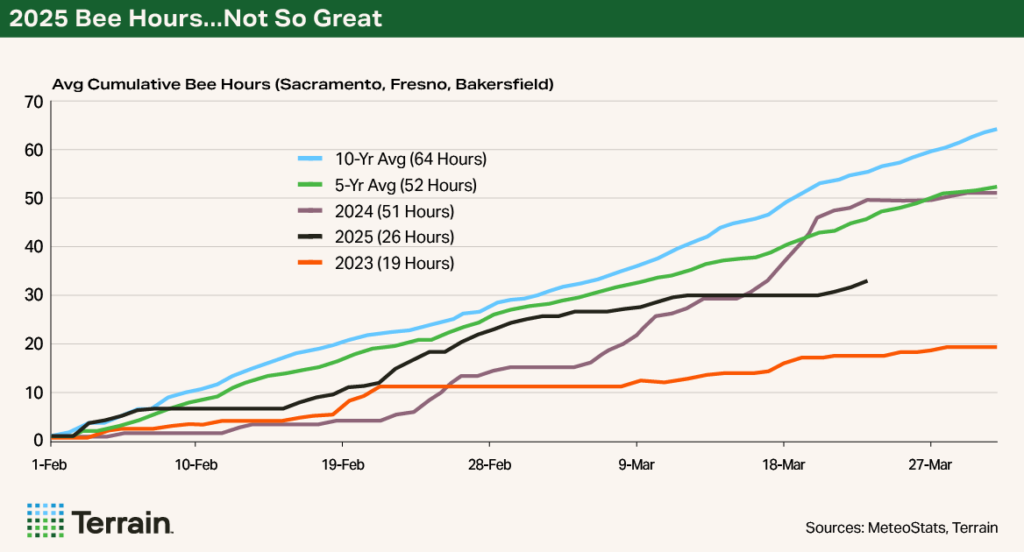Situation
Opinions on bloom have been varied, with some noting mostly dry conditions while others are focusing on the sporadic rain and hail the Central Valley has received throughout bloom.
Spotty weather across regions has corresponded with differences in bloom timing.
To better understand what’s occurred, I’ve utilized weather data to formulate an estimate of how many bee hours we’ve had in 2025 relative to previous years. While 2025 bloom conditions have been better than 2023, they’ve fallen short of last year and historical averages. In addition, other factors like reduced inputs and bee shortages could reduce yields further and, in general, have increased uncertainty.
Bloom Analysis
The 2025 on-ground bloom assessment has been varied. Spotty weather across regions has corresponded with differences in bloom timing. In addition to differences in timing by area, there have also been discrepancies by variety. Independence, Aldrich and Butte-Padre varieties have seen stronger, more uniform blooms, while Nonpareil (which represents 40% of total production) has had less favorable bloom.
On-ground observations are valuable, but so is analysis of the weather data. By utilizing data from the Sacramento, Fresno and Bakersfield airport weather stations, I evaluate the cumulative bee hours from February 1 to March 31, enabling a comparison of 2025 to previous periods. Although there are minor discrepancies in defining ideal pollination conditions, I define a bee hour as any hour with temperatures above 59°F, wind speeds below 10 mph, and no precipitation.


Weather factors like chill hours and excess summer heat could affect the 2025 crop.
My analysis confirms on-ground observations.
- 2025 bloom conditions have been better than the lows of 2023, but below last year and historical averages.
- There was higher bee hour variance between regions in the early and middle part of bloom, aligning with the variation reported by those in the field. More recent data, however, have been much less varied.
It’s also important to remember that bloom conditions only account for about 25% of yield variation at most, according to my estimates. Other weather factors like chill hours and excess summer heat could affect the 2025 crop. Non-weather factors like widely reported bee shortages and growers cutting inputs due to the poor economics of recent years could prove important for this year’s yields, too. These additional factors add to the unpredictability and are likely to lower yields.
Outlook
Given the inherent uncertainty around predicting crop size, it seems possible that yields will be between those during 2023 and 2024, both of which were below historical averages. Given variation in the data and the non-weather factors, however, uncertainty remains high around any estimate.
The market appears to confirm this lack of clarity, with prices remaining mostly unmoved this bloom period. This contrasts with the steep price rise in spring 2023 and the sharp drop at this time last year, when, for better or worse, industry consensus was clear.
Terrain content is an exclusive offering of AgCountry Farm Credit Services,
American AgCredit, Farm Credit Services of America and Frontier Farm Credit.